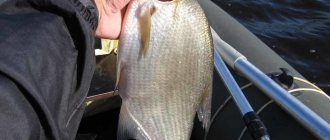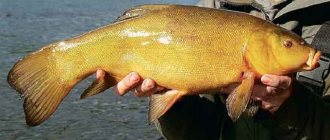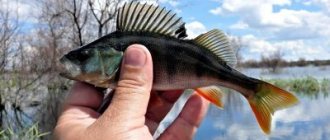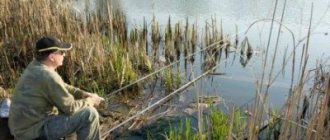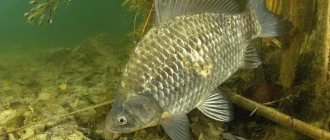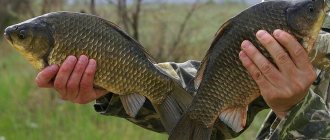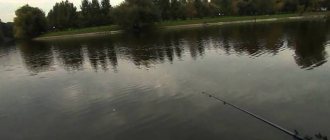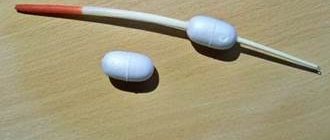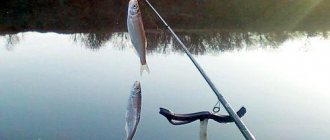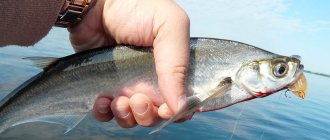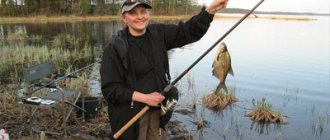Selecting a location
The nature of the “striped” habitat directly depends on the type of reservoir and time of year. In small shallow rivers, perch prefers to stay in places with no current:
- in coastal pools;
- behind the pitfalls;
- on bends;
- in the creeks.
In lakes and reservoirs, “striped” should be looked for at a depth of 2 to 4 m, on sand spits and underwater hills. The coastal zone of standing reservoirs, as a rule, is inhabited by small grass perches, rarely reaching a mass of more than 100 g. On large rivers, perch adheres to:
- coastal dumps;
- channel edges;
- stuck areas;
- places with sharp changes in depth.
The bays and oxbows of large rivers are the permanent habitats of this predator. When fishing, you should pay attention to fry jumping out of the water and clusters of terns above the water, as this is a sure sign that the striped fish is fattening. The effectiveness of fishing largely depends on the angler’s knowledge of the river’s bottom topography.
In the spring, when the water has not yet warmed up, perch hunts at depths of no more than one and a half meters, where the greatest concentration of fry and other food items is observed. As the water warms and aquatic vegetation grows, the fry moves to areas with a depth of 1.5–3 m, followed by perch. Catching perch in the summer with a float rod involves constantly changing places.
With the autumn cooling of the water, the “striped” one moves to places with depths of 4 to 7 m, where it remains until spring. Small grass perch does not leave the coastal zone throughout the year and is consistently caught using float gear.
Search for a place
Larger perch can be caught with fry, and you can even catch a real trophy
In any pond there are places where perch chase fry. Most often these are smaller places where fry and small fish feed. You can try fishing here, or you can make bait.
The bait is not made for perch, but for small fish; a piece of white bread (floating on the surface) is an ideal option. But if you just throw it out, it will drift, and perhaps go far from the shore, thereby taking with it a school of fry, and then a perch.
Use a separate rig on your spinning rod. At the very end there is a sinker, and two meters above (or a meter if the place where you will be fishing is shallow) a crust of bread. Throw the bait equipment into the place you need and the little things will immediately begin to collect.
Don’t try to throw bait too far, small fish may not find bread above deep places, 5-10 meters from the shore is enough.
Fishing with a float rod - a complete guide with all the intricacies of preparing equipment, bait and everything about fishing techniques.
Fly fishing for beginners - casting technique, selection of baits and full equipment of tackle.
Fishing for crucian carp on a float rod - the intricacies of crucian carp equipment and bait.
Timing
Spring is the best time to catch perch with a float. At the beginning of May, the perch begins to eat, and it greedily rushes to the bait offered to it. In spring there is no need to come to the pond with the first rays of the sun. It is better to start fishing at 7–8 o’clock in the morning, when the sun warms up the coastal shallows and the fry come out of their night shelters. In the summer months, the behavior of the “striped” is changeable. The fish bite is greatly influenced by:
- Atmosphere pressure;
- water temperature;
- water level in the reservoir;
- other natural factors.
During the summer, the predator shows increased activity at dawn. The bite begins at sunrise and continues until 8–9 am. For fishing, it is better to choose quiet, cloudy days.
In the fall, the “striped” gathers in large flocks and begins to actively feed, stocking up on fat for the winter. Catching perch in the fall with a float rod can be very productive. If the angler managed to find a school of predator, then a good bite can continue throughout the daylight hours. Perch is a typical diurnal predator, feeding only during daylight hours. Captures of it at night are extremely rare.
Tactics and techniques of fishing with a float rod
After discovering the supposed place of life of the striped fish, you can begin to bait. If the casting is planned at a short distance from the coastal zone, then you can make bait in the form of bread crumbs - this will help attract the fry and fish that perches feed on. Thus, after a while he will come to the feeding place to hunt.
On small-sized reservoirs, using a fly rod, it is better to set the float depth to within one meter. When a striped fish bites, it takes the float completely under the water - at this moment you need to hook so that the slave does not fall off.
For casting to the middle, it is better to use a mast fishing rod: fishing with live fish will bring good results in this case. When setting out to catch such a nimble and voracious fish as a perch, it is worth considering several factors: if the reservoir is shallow and it freezes completely in winter, then the likelihood that a striped fish lives there is very small.
In addition, it is worth asking fishermen and local residents near the proposed fishing in advance whether such fish live in this place or not. And, of course, it is worth remembering that fish is a living creature, and on a hot day, just like any other living creature, it tries to hide from the heat and becomes lethargic, so you should also choose the fishing time wisely. And with a good attitude and quality gear, every fishing trip can bring pleasure and a lot of positive emotions.
In most cases, this simple method produces results. The important thing is to just find a good place. Because if the fish in the pond are tight, or the period is not right, you can waste time and nerves and not catch anything.
Tackle
Various types of float gear are used for perch fishing. In the spring and summer, when the fish stands a short distance from the shore, a classic fly rod with blind equipment, 5–8 m long, is suitable for fishing for “striped fish”. This equipment allows you to make precise casts and quickly transfer the equipment.
For autumn perch fishing, it is better to use a match rod equipped with a spinning reel. Since fishing is carried out at a considerable distance from the shore, the reel must have a large additional number of bearings, which will allow you to quickly reel in the equipment. With the help of match gear, an angler can cast the equipment 40–50 m from the shore, significantly expanding the range of fishing.
When fishing in the current, a Bolognese fishing rod is used, which allows for good control of the tackle during fishing. Plug-in float tackle is rarely used for targeted fishing of perch, since it is designed for stationary fishing and does not provide for constant movements around the reservoir.
Equipment used
Float rigs for perch fishing are quite simple. They use monofilament lines with a diameter of up to 0.18 mm and floats with a weight of one and a half to four grams (when fishing with live bait up to 10–15 g). The type and shape of the float depends on the conditions and fishing method. Hooks are used with a straight and long shank. It is better to avoid using metal leashes.
Although the perch is not particularly careful, it is better to use the lightest possible equipment. This increases both the comfort of fishing and the number of bites.
This option is used when catching perch in summer in snags or if the area of the reservoir is heavily overgrown with grass. The bait is attached to the main fishing line on an offset hook, approximately 75 cm above which, a retractable leash with a bullet-shaped sinker is attached through a triple swivel.
Equipment
In perch fishing, the correct construction of equipment plays a decisive role. The fly rod equipment consists of the following elements:
- main line with a diameter of 0.14–0.16 mm;
- float with a load capacity of 1.5–3 g;
- main set of weights;
- sinkers;
- leash 15–20 cm long, diameter 0.10–0.14 mm;
- hook No. 16–8 (according to international classification).
The equipment is attached to the fishing rod using a special connector fixed at the end of the fishing rod. The thickness of the main line and leader is selected taking into account the size of the expected prey.
The carrying capacity of the float depends on the depth at the fishing site and the strength of the wind. The greater the depth and the stronger the wind, the greater the carrying capacity. The sinker-reinforcer is attached to the main line at the point of its connection with the leash, and the main mass of the sinkers is located 70 cm higher. This distribution of the load ensures natural immersion of the bait and does not scare away cautious fish.
The leash is attached to the main line using the “loop-to-loop” method. The size of the hook depends on the type of bait used. For fishing on a worm or fry, a hook No. 10–8 is suitable. If bloodworms or maggots are used as bait, the hook size should not exceed No. 12.
The equipment of a match rod differs from the fly version in the design of the float and its load capacity. The match float has its own partial load, which is built into the body of the float. This float has a long body and one attachment point, which has a positive effect on casting distance. Long-distance fishing allows the angler to count on catching a large predator. The rigging of a Bolognese fishing rod for currents is no different from a fly fishing rod.
Equipment of a float rod for perch
You need a moderately stiff fishing rod to quickly pull a resisting perch out of the water. Long-term fishing with releasing and sipping the fish that has bitten is undesirable. Of course, if a kilogram specimen is bitten, they are fished according to the classical scheme (pulling - reeling in the fishing line), thereby preventing damage to the gear. For such large perches, use a fishing line with a cross-section of 0.18 - 0.22 mm, in some cases - up to 0.25 mm.
If in fishing areas the perch does not exceed 800 grams, it is advisable to use a fishing line with a diameter of 0.14 - 0.16 mm. The choice of fishing line depends not only on the expected trophy, but also on its quality, since it is preferable to use a thinner fishing line. A float fishing rod for perch is equipped with hooks No. 5–7 according to Russian numbering, with a long shank (Classification and numbering of fishing hooks). For fishing with live bait, use hook No. 9–10. Floats are used with a carrying capacity from 6 to 12 grams.
The usual length of a float rod for perch is 4–5 meters. For fishing in small bodies of water, a simple rod without rings and a reel will be enough. When fishing for perch at a distance of 9–15 meters (or more), the angler is required to use a float rod equipped with a spinning reel and a sliding float. Read more about the equipment of these fishing rods in the following articles:
Photo by Anatoly Mailkov
Photo by Anatoly Mailkov
This question is very relevant for some anglers during the period of the ban on spinning fishing. Perch has now spawned in most reservoirs and has begun to show enviable activity.
There is another aspect to fishing with a float rod. If you use well-known literary tips, you will most likely catch perch by chance. There is nothing strange in this, since fishing authors have never set themselves a special task of catching perch with float tackle in late spring.
It is almost always possible to catch several perches on a worm using rough tackle, as well as several bleaks on bread. In order to truly catch perch effectively and almost regardless of the weather and time of year, a different approach is needed. Today we will focus on fishing when the perch, for one reason or another, is not going to attack the worm. I would also not like to discuss fishing with live bait today, since such fishing is good in the fall and the time for it will come.
[THERE IS AN ANSWER] What boilies are best for catching carp in the summer?
Perch should be caught like bleak. That is, at a fast but measured pace, showing maximum personal activity. Of course, groundbait and lures are different, but what unites bleak and perch fishing is the tackle and general fishing technique.
If we talk about the size of the hook, I prefer to use the “round bend” or “kirby” models with sizes 20 and 18, since bloodworms are most often used. Even if I use a worm or klepsin, I do not use hooks larger than No. 16. I never use hooks with a short shank. Interestingly, the color of the hook sometimes matters, and then the perch prefers, as in winter, golden-colored hooks.
The fishing technique is very simple, since the distance is usually short and amounts to 3-7 meters. Fishing is carried out above the first coastal edge, at the edge of coastal vegetation. Sometimes the depth at the fishing point is only 20-30 cm, which predetermines the need for camouflage. Slow artificial wiring along the shore is almost always necessary.
It should also be noted that bites are often so careful that they are visible only on very light equipment. As for feeding, one hundred grams of small “clean” bloodworms, but soaked in water, is enough, which is thrown to the fishing point in doses comparable to winter ones. That is, you need to feed often, but in very small doses.
Try it, and it will be enough to catch ten times as many perches in a well-known place once, and you will appreciate the subtle, sporty approach.
There are two types of perch in reservoirs. The first is fish living in the coastal zone overgrown with vegetation. They feed daily, much like rotan. It eats everything, and given the abundance of different food in the river, it is difficult to catch a lot of such fish. The second type is deep perch, feeding on caddis flies and bloodworms. He rarely comes to the shore. But the size is slightly larger than the first type.
Baits
Perch is a predatory fish, so it should be caught using bait of animal origin. The most common baits when fishing for “striped” include:
- worm;
- fry;
- maggot;
- bloodworm.
Catching perch with a worm is more effective on rivers, since the fish are accustomed to the fact that during high water periods worms enter the water in large numbers. Whitebait is a universal bait that works well throughout the entire period of open water.
Maggot - used as independent bait, as well as as an addition to bloodworms or worms. Perch reacts better to brightly colored maggots. The procedure for staining larvae consists of several stages:
- the larvae are placed in a deep container and moistened with water;
- the moistened maggot is sprinkled with a small amount of food coloring and left for 5 minutes;
- after 5 minutes, the larvae are transferred to a colander and washed under running cold water;
- the painted maggot is sprinkled with sawdust.
As you fish, it makes sense to experiment with different bait color combinations. Bloodworms are a good bait for fishing in late autumn, when the perch becomes passive and switches to the winter feeding mode.
Catching perch with a worm
When fishing for perch, it is better to use dung worms about 5 cm long. You should not give preference to purchased worms, which stick well to the hook, but do not have a specific smell that attracts fish well.
When hooked, the worm should be pierced in several places, while the 2-3 centimeter long tip should remain mobile, which will serve as an additional irritant for the fish.
Catching perch with fry
The fry can be caught directly at the fishing site, using a special lift or a landing net with a fine mesh. It is better to use carp fish as bait:
- roach;
- bleak;
- rudd;
- crucian carp
The size of the bait for small and medium-sized predators should not exceed 5 cm. If there is a large perch in the reservoir chosen for fishing, you will need a small fish 7–10 cm long. To prevent the bait from flying off the hook during casting, the fish should be baited by passing the hook through its nostril. A special feature of the float rod equipment when fishing perch for fry is the length of the leash, which should be at least 50 cm. A long leash does not limit the movement of the fry, which makes the bait more attractive to the predator.
Float tackle for perch fishing
Content
When fishing for perch, you can use any type of float rod - fly rod, match rod, Bolognese rod or plug rod. Of course, each of them has its own advantages and disadvantages.
Fly fishing rod
A telescopic fishing rod with a blind rig is used both in shore fishing and in fishing from a boat. Well known to everyone, simple and convenient, the fly rod allows you to catch almost any fish. Its significant disadvantage is the short casting range. When fishing from a boat, it is better to use rods 4–5 meters long, and for fishing from the shore – a rod 5–7 m long.
Fly rod for catching perch
Match fishing rod
The match fishing rod is designed for long-cast fishing. Its area of application is fishing for small fish in shallow reservoirs with standing water or weak currents.
It is better to catch perch for the match in lakes, ponds and bays with extensive coastal shallow waters. They are usually caught with a match rod using a worm or maggot. More delicate baits, such as whitebait, are often damaged when they hit the water or are torn off when casting hard.
Bolognese fishing rod
The Bolognese fishing rod is a telescopic rod 5–7 meters long with guide rings and a spinning reel. This is probably the best option for catching perch. Despite the fact that the main purpose of the Bolognese fishing rod is fishing with a retrieve in the current, it allows both long casts and short-range fishing.
Plug fishing rod
Plug fishing rods appeared relatively recently. These are float rods from 8 to 18 meters long with shortened blind equipment. The technique and tactics of fishing with a plug fishing rod are fundamentally different from fishing with other float gear. The niche for using a plug fishing rod is sports competitions and reservoirs with a free area for maneuvering the rod.
Despite a number of advantages, using a plug specifically for perch fishing is unjustified.
Read more
How to properly load a float on a fishing rod?
Plug fishing rod for perch
Bait for perch
Baits for catching perch are made from dry beef blood. To be able to form bait balls, dry blood will need to be mixed with moistened soil in a 1:1 ratio. To increase efficiency, live components are added to the bait:
- chopped worm;
- bloodworm;
- maggot.
To attract “striped fish” to the fishing site, you can use bright trout baits containing not only amino acids and flavoring additives, but also sparkles that attract fish from afar.
How to catch perch with a float rod
Arriving at a pond, the angler chooses the most promising place for fishing, prepares a bait mixture and sets up the tackle. Before setting the bait, the fisherman sets the release of the float so that the hook is 2–5 cm from the bottom. After setting the working depth, the angler baits the hook, throws the equipment and throws 2-3 balls of bait the size of an orange at the fishing point.
If within a few minutes the fish has not shown itself in any way, you should experiment with the fishing depth, reducing the descent of the float. If there is no bite, you need to change the type of bait. If manipulations with changing the fishing horizon and changing bait do not bring results, then you should move to another place.
Catching perch with a fishing rod is a constant experiment involving the search for the optimal composition of the bait mixture, selection of the required depth and choice of bait.
Habitats
What else can you do to tempt a perch? In addition to silicone, the following are recognized as effective perch baits:
- rotating and oscillating spinners that imitate the movements of live fish;
- small wobblers with natural or spotted colors;
- Tailspinners are artificial fish, very successfully complemented by a petal.
[THERE IS AN ANSWER] In what wind does fish bite better in summer?
You can catch perch using a spinning rod using uniform and stepped retrieves, as well as the twitching method. The first is more suitable for wobblers and silicone baits, the stepped one is good for fishing in deep places in search of a trophy predator, and the twitch is effective in a variety of conditions throughout the open water season.
Usually a bite is felt in the hand like a blow, sometimes it feels like a hook. In any case, you need to make a hook, but not too sharp and sweeping, otherwise only the predator’s lip will remain on the hook.
The match fishing rod is designed for long-cast fishing. Its area of application is fishing for small fish in shallow reservoirs with standing water or weak currents.
